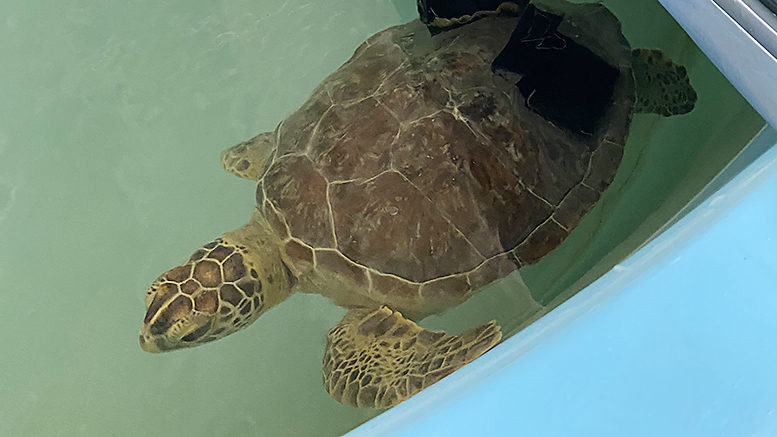By Kayla McManama
Sea turtles have been around for 110 million years, but as Florida’s population continues to grow, their population is declining.
Catherine Eastman is the Sea Turtle Program Manager at the Sea Turtle Hospital at Whitney Laboratory. In its four years of existence, the sea turtle hospital has seen many sea turtles, mostly green sea turtles, with conditions ranging from tumors to boat strikes. However, she said human impact, specifically from habitat loss, is the main cause of the population decline.
“The key to reproduction is a dry sandy beach … The worst thing for a beach is to have a hardened sea wall that when the tide comes in it’s at the wall and there’s no sand,” Eastman said. “You just lost all that nesting beach, and so for an animal who comes back to its home beach to lay eggs, you’ve man made wiped out nesting.”
According to Sea Turtle Conservancy, Florida’s nesting beaches host approximately 90 percent of all sea turtle nesting in the United States and sea wall construction is becoming a serious threat to those nesting beaches.
“We’re, unfortunately, fighting ourselves because humans want that sandy beach for that ocean view,” Eastman said. “That habitat loss will be the main reason for this species to go extinct.”
Lexie Beach is the communications coordinator at the Sea Turtle Conservancy, and like Eastman, she said the sea turtle population started declining due to human-related activities.
“Sea turtles have been around since the time of the dinosaurs, and only started declining because of human-related activities,” she said. “So it’s very important to me that we protect and preserve them at all costs.”
The amount of plastic debris dumped in the ocean also affects sea turtles and other marine life. “Over 1 million marine animals (including mammals, fish, sharks, turtles and birds) are killed each year due to plastic debris in the ocean. More than 80 percent of this plastic comes from land,” according to the Sea Turtle Conservancy.
“One of the easiest ways to help sea turtles (and all marine life) is to cut back on the amount of single-use plastic you purchase and use on a daily basis,” Beach said. “If enough people make small changes to their daily lives, it can end up making a big impact. Switch to reusable items or choose glass over plastic whenever you can because marine debris is a huge problem for all marine life right now.”
Bob Fraser has been a Sea Turtle Patrol volunteer on St. Augustine Beach since 2012. Fraser and his team survey about six and half miles of the beach.
“The first half of the season, we walk the beach or some of us will drive our cars and we look for the tracks coming up. They look like a big tire track, you can’t miss it. We have to have that done by 8 a.m. so they can open up for the public,” Fraser said. “The second half of the season we look for signs of emergence and at the same time you are looking for any other signs of predation, whether it’s crabs, birds, raccoons, foxes, coyotes along with poachers.”
Both Beach and Fraser agree that seeing a sea turtle nest is an experience that never gets old.
“I walked over and saw some hatchling tracks and I couldn’t tell where they were originating from and I was looking around and about 22 hatchlings came out between my feet. It was a nest that was unmarked and I just happened to be standing on it. It was kind of like hitting the lottery. When you see it, it never gets old,” Fraser said.
In order to help the sea turtles, Fraser, Eastman and Beach believe that education about the topic and having the community work together to save this species, and other animal species, as well.
“As a community a lot can be done, but I think you need someone to be a voice,” Fraser said. “You have to get that word out and you have to educate the public.”
He said it has to be a group effort as a community, but he also thinks people need to think more globally and to really become aware of the need to protect all animals and natural environments.
“You can’t just be an advocate for one species – you have to appreciate nature,” he said. “It’s making an impact as a community. It starts with you as an individual and then you expand on it from there.”



Be the first to comment on "Wildlife Protection: Sea turtles struggle as Florida continues to grow"